Aerosol Monitoring at High Mountains Remote Station: A Case Study on the Yunnan Plateau (China)
Abstract
:1. Introduction
2. Materials and Methods
2.1. Data Campaign and Site Description
2.2. Experimental Setup
3. Results
4. Discussion
5. Conclusions
Author Contributions
Funding
Data Availability Statement
Acknowledgments
Conflicts of Interest
References
- Pósfai, M.; Molnár, Á. Aerosol Particles in the Troposphere: A Mineralogical Introduction; Mineralogical Society of Great Britain and Ireland: Twickenham, UK, 2000; pp. 197–252. [Google Scholar] [CrossRef]
- Mahowald, N.; Ward, D.S.; Kloster, S.; Flanner, M.G.; Heald, C.L.; Heavens, N.G.; Hess, P.G.; Lamarque, J.-F.; Chuang, P.Y. Aerosol impacts on climate and biogeochemistry. Annu. Rev. Environ. Resour. 2011, 36, 45–74. [Google Scholar] [CrossRef] [Green Version]
- Quan, J.; Gao, Y.; Zhang, Q.; Tie, X.; Cao, J.; Han, S.; Meng, J.; Chen, P.; Zhao, D. Evolution of planetary boundary layer under different weather conditions, and its impact on aerosol concentrations. Particuology 2013, 11, 34–40. [Google Scholar] [CrossRef]
- Jaenicke, R. Chapter 1 Tropospheric Aerosols. In Hobbs, International Geophysics; Peter, V., Ed.; Academic Press: Cambridge, MA, USA, 1993; Volume 54, pp. 1–31. ISSN 0074-6142. ISBN 9780123507259. [Google Scholar] [CrossRef]
- Bitar, L.; Duck, T.J.; Kristiansen, N.I.; Stohl, A.; Beauchamp, S. Lidar observations of Kasatochi volcano aerosols in the troposphere and stratosphere. J. Geophys. Res. Atmos. 2010, 115, 1–2. [Google Scholar] [CrossRef] [Green Version]
- Smith, W. The cost of stratospheric aerosol injection through 2100. Environ. Res. Lett. 2020, 15, 114004. [Google Scholar] [CrossRef]
- Sagar, R.; Kumar, B.; Dumka, U.C.; Moorthy, K.K.; Pant, P. Characteristics of aerosol spectral optical depths over Manora Peak: A high-altitude station in the central Himalayas. J. Geophys. Res. Atmos. 2004, 109, 1–8. [Google Scholar] [CrossRef] [Green Version]
- Pan, Z.; Zhu, J.; Liu, J.; Gu, J.; Liu, Z.; Qin, F.; Pan, Y. Estimation of air temperature and the mountain-mass effect in the Yellow River Basin using multi-source data. PLoS ONE 2021, 16, e0258549. [Google Scholar] [CrossRef] [PubMed]
- Zhou, S.; Collier, S.; Jaffe, D.A.; Zhang, Q. Free tropospheric aerosols at the Mt. Bachelor Observatory: More oxidized and higher sulfate content compared to boundary layer aerosols. Atmos. Chem. Phys. 2019, 19, 1571–1585. [Google Scholar] [CrossRef] [Green Version]
- Ou-Yang, C.-F.; Lin, N.-H.; Lin, C.-C.; Wang, S.-H.; Sheu, G.-R.; Lee, C.-T.; Schnell, R.; Lang, P.M.; Kawasato, T.; Wang, J.-L. Characteristics of atmospheric carbon monoxide at a high-mountain background station in East Asia. Atmos. Environ. 2014, 89, 613–622. [Google Scholar] [CrossRef]
- Buchunde, P.S.; Safai, P.D.; Mukherjee, S.; Raju, M.P.; Meena, G.S.; Sonbawne, S.M.; Pandithurai, G. Seasonal abundances of primary and secondary carbonaceous aerosols at a high-altitude station in the Western Ghat Mountains, India. Air Qual. Atmos. Health 2022, 15, 209–220. [Google Scholar] [CrossRef]
- Gao, Y.; Wang, Q.; Li, L.; Dai, W.; Yu, J.; Ding, L.; Li, J.; Xin, B.; Ran, W.; Han, Y.; et al. Optical properties of mountain primary and secondary brown carbon aerosols in summertime. Sci. Total Environ. 2022, 806, 150570. [Google Scholar] [CrossRef]
- Perezramirez, D.; Aceituno, J.; Ruiz, B.; Olmo, F.; Alados-Arboledas, L. Development and calibration of a star photometer to measure the aerosol optical depth: Smoke observations at a high mountain site. Atmos. Environ. 2008, 42, 2733–2738. [Google Scholar] [CrossRef]
- Xia, X.; Zong, X.; Cong, Z.; Chen, H.; Kang, S.; Wang, P. Baseline continental aerosol over the central Tibetan plateau and a case study of aerosol transport from South Asia. Atmos. Environ. 2011, 45, 7370–7378. [Google Scholar] [CrossRef]
- Draxler, R.R. HYSPLIT4 User’s Guide; NOAA Tech. Memo. ERL ARL-230; NOAA Air Resources Laboratory: Silver Spring, MD, USA, 1999.
- Available online: https://www.arl.noaa.gov/hysplit/ (accessed on 22 June 2022).
- Escudero, M.; Stein, A.; Draxler, R.R.; Querol, X.; Alastuey, A.; Castillo, S.; Avila, A. Determination of the contribution of northern Africa dust source areas to PM10 concentrations over the central Iberian Peninsula using the Hybrid Single-Particle Lagrangian Integrated Trajectory model (HYSPLIT) model. J. Geophys. Res. Atmos. 2006, 111, 1–4. [Google Scholar] [CrossRef]
- Uno, I.; Eguchi, K.; Yumimoto, K.; Takemura, T.; Shimizu, A.; Uematsu, M.; Liu, Z.; Wang, Z.; Hara, Y.; Sugimoto, N. Asian dust transported one full circuit around the globe. Nat. Geosci. 2009, 2, 557–560. [Google Scholar] [CrossRef]
- Sannino, A. Atmospheric Particles Properties Retrieval in China-Italy Aerosol Multi-Wavelength Polarization Lidar Experiment (AMPLE) Systems. Ph.D. Thesis, University “Federico II” di Napoli, Napoli, Italy, 2017. [Google Scholar]
- Boselli, A.; Scollo, S.; Leto, G.; Sanchez, R.Z.; Sannino, A.; Wang, X.; Coltelli, M.; Spinelli, N. First volcanic plume measurements by an elastic/Raman Lidar close to the Etna summit craters. Front. Earth Sci. 2018, 6, 125. [Google Scholar] [CrossRef]
- Zhao, Y.; Li, Y.; Li, L.; Yu, Y.; Pan, C.; Song, C.; Boselli, A.; Pisani, G.; Spinelli, N.; Wang, X. Implementation of high dynamic Raman lidar system for 3D map of particulate optical properties and their time evolution. Int. J. Remote Sens. Appl. 2013, 3, 240. [Google Scholar] [CrossRef]
- Wang, X.; Boselli, A.; Sannino, A.; Song, C.; Spinelli, N.; Zhao, Y.; Pan, C. Calibration of multi-wavelength raman polarization lidar. EPJ Web Conf. 2015, 89, 1002, EDP Sciences. [Google Scholar] [CrossRef] [Green Version]
- Klett, J.D. Stable analytical inversion solution for processing lidar returns. Appl. Opt. 1981, 20, 211–220. [Google Scholar] [CrossRef] [Green Version]
- Fernald, F.G. Analysis of atmospheric lidar observations: Some comments. Appl. Opt. 1984, 23, 652–653. [Google Scholar] [CrossRef]
- Liu, T.; He, Q.; Chen, Y.; Liu, J.; Liu, Q.; Gao, W.; Huang, G.; Shi, W.; Yu, X. Long-term variation in aerosol lidar ratio in Shanghai based on Raman lidar measurements. Atmos. Chem. Phys. 2021, 21, 5377–5391. [Google Scholar] [CrossRef]
- Dong, Q.; Huang, Z.; Li, W.; Li, Z.; Song, X.; Liu, W.; Wang, T.; Bi, J.; Shi, J. Polarization Lidar Measurements of Dust Optical Properties at the Junction of the Taklimakan Desert–Tibetan Plateau. Remote Sens. 2022, 14, 558. [Google Scholar] [CrossRef]
- Omar, A.H.; Winker, D.M.; Vaughan, M.A.; Hu, Y.; Trepte, C.R.; Ferrare, R.A.; Lee, K.-P.; Hostetler, C.A.; Kittaka, C.; Rogers, R.R.; et al. The CALIPSO automated aerosol classification and lidar ratio selection algorithm. J. Atmos. Ocean. Technol. 2009, 26, 1994–2014. [Google Scholar] [CrossRef]
- Liu, Z.; Sugimoto, N.; Murayama, T. Extinction-to-backscatter ratio of Asian dust observed with high-spectral-resolution lidar and Raman lidar. Appl. Opt. 2002, 41, 2760. [Google Scholar] [CrossRef] [Green Version]
- Rocadenbosch, F.; Reba, M.N.; Sicard, M.; Comerón, A. Practical analytical backscatter error bars for elastic one-component lidar inversion algorithm. Appl. Opt. 2010, 49, e3380–e3393. [Google Scholar] [CrossRef] [PubMed]
- Chen, W.-N.; Tsai, F.; Chou, C.; Chang, S.; Chen, Y.; Chen, J. Optical properties of Asian dusts in the free atmosphere measured by Raman lidar at Taipei, Taiwan. Atmos. Environ. 2007, 41, 7698–7714. [Google Scholar] [CrossRef]
- Guerrero-Rascado, J.L.; Ruiz, B.; Alados-Arboledas, L. Multi-spectral Lidar characterization of the vertical structure of Saharan dust aerosol over southern Spain. Atmos. Environ. 2008, 42, 2668–2681. [Google Scholar] [CrossRef]
- Freudenthaler, V.; Esselborn, M.; Wiegner, M.; Heese, B.; Tesche, M.; Ansmann, A.; Müller, D.; Althausen, D.; Wirth, M.; Fix, A.; et al. Depolarization ratio profiling at several wavelengths in pure Saharan dust during SAMUM 2006. Tellus B Chem. Phys. Meteorol. 2009, 61, 165–179. [Google Scholar] [CrossRef] [Green Version]
- Pisani, G.; Boselli, A.; Coltelli, M.; Leto, G.; Pica, G.; Scollo, S.; Spinelli, N.; Wang, X. Lidar depolarization measurement of fresh volcanic ash from Mt. Etna, Italy”. Atmos. Environ. 2012, 62, 34–40. [Google Scholar] [CrossRef]
- State of Environmental of Assam. 2014. Available online: http://www.pcbassam.org/publications/State%20of%20Env%20of%20Assam.pdf (accessed on 22 April 2022).
- Bhunia, G.S.; Ding, D. Temporal and spatial statistical analysis of ambient air quality of Assam (India). J. Air Waste Manag. Assoc. 2020, 70, 775–794. [Google Scholar] [CrossRef]
- Chen, X.; Škerlak, B.; Rotach, M.W.; Añel, J.A.; Su, Z.; Ma, Y.; Li, M. Reasons for the extremely high-ranging planetary boundary layer over the western Tibetan Plateau in winter. J. Atmos. Sci. 2016, 73, 2021–2038. [Google Scholar] [CrossRef]
- Zhao, C.; Yang, Y.; Fan, H.; Huang, J.; Fu, Y.; Zhang, X.; Kang, S.; Cong, Z.; Letu, H.; Menenti, M. Aerosol characteristics and impacts on weather and climate over the Tibetan Plateau. Natl. Sci. Rev. 2020, 7, 492–495. [Google Scholar] [CrossRef] [PubMed]
- Pokharel, M.; Guang, J.; Liu, B.; Kang, S.; Ma, Y.; Holben, B.N.; Xia, X.; Xin, J.; Ram, K.; Rupakheti, D.; et al. Aerosol properties over Tibetan Plateau from a decade of AERONET measurements: Baseline, types, and influencing factors. J. Geophys. Res. Atmos. 2019, 124, 13357–13374. [Google Scholar] [CrossRef]
- Kahnert, M.; Kanngießer, F. Modelling optical properties of atmospheric black carbon aerosols. J. Quant. Spectrosc. Radiat. Transf. 2020, 244, 106849. [Google Scholar] [CrossRef]
- Sannino, A.; Amoruso, S.; Damiano, R.; Scollo, S.; Sellitto, P.; Boselli, A. Optical and microphysical characterization of atmospheric aerosol in the Central Mediterranean during simultaneous volcanic ash and desert dust transport events. Atmos. Res. 2022, 271, 106099. [Google Scholar] [CrossRef]
- Huang, J.; Minnis, P.; Yi, Y.; Tang, Q.; Wang, X.; Hu, Y.; Liu, Z.; Ayers, K.; Trepte, C.; Winker, D. Summer dust aerosols detected from CALIPSO over the Tibetan Plateau. Geophys. Res. Lett. 2007, 34, 1–5. [Google Scholar] [CrossRef] [Green Version]
- Sugimoto, N.; Matsui, I.; Shimizu, A.; Uno, I.; Asai, K.; Endoh, T.; Nakajima, T. Observation of dust and anthropogenic aerosol plumes in the northwest Pacific with a two-wavelength polarization lidar on board the research vessel Mirai. Geophys. Res. Lett. 2002, 29, 7-1–7-4. [Google Scholar] [CrossRef] [Green Version]
- Das, M.; Patel, D.K.; Sarma, A.K.; Baruah, B.K.; Banu, S.; Kotoky, J. Assessment of polycyclic aromatic hydrocarbons and heavy metals pollution in soils of Guwahati city, Assam, India. Curr. Sci. 2016, 110, 2285–2292. Available online: http://www.jstor.org/stable/24908474 (accessed on 22 June 2022). [CrossRef]

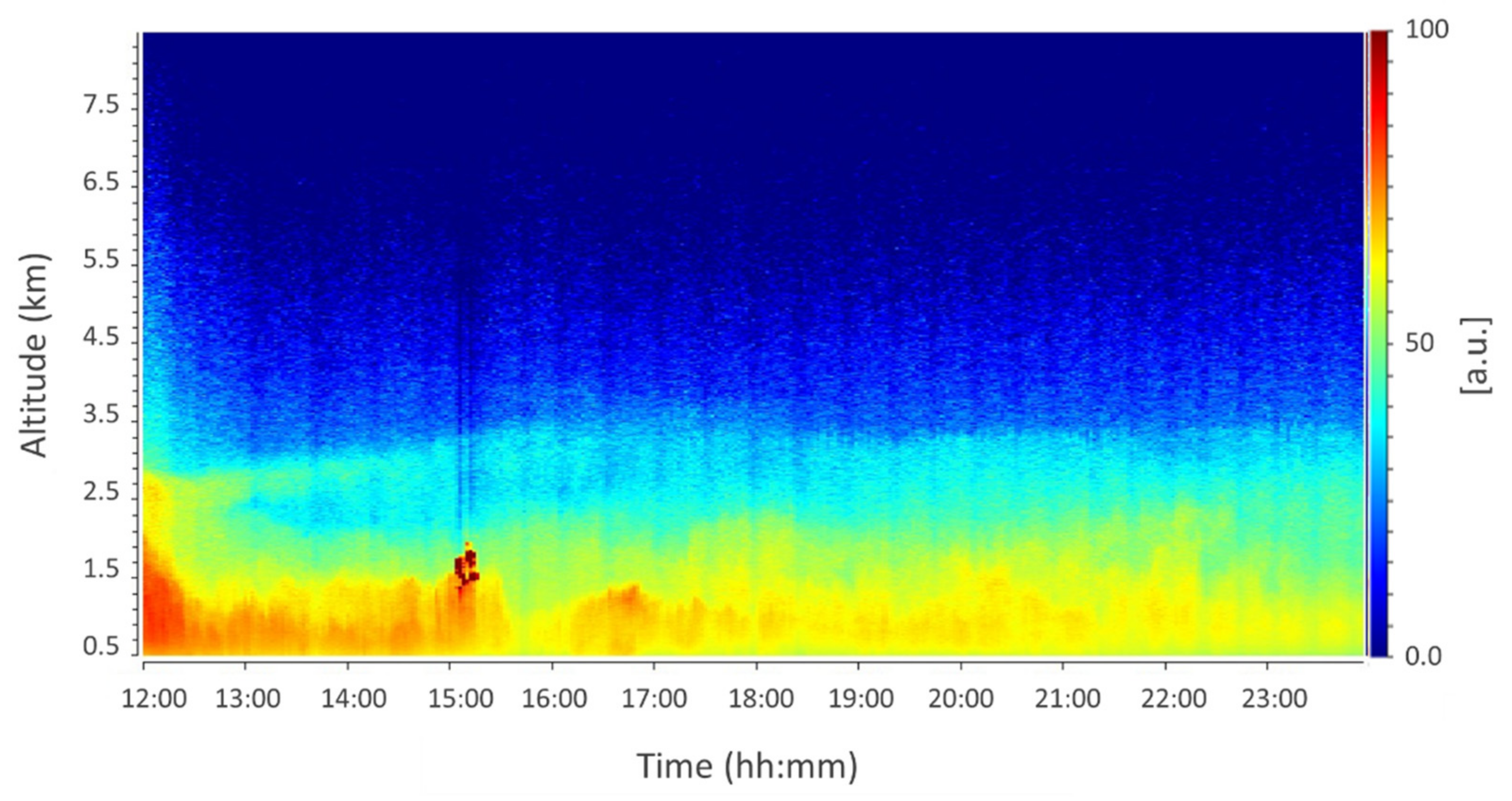
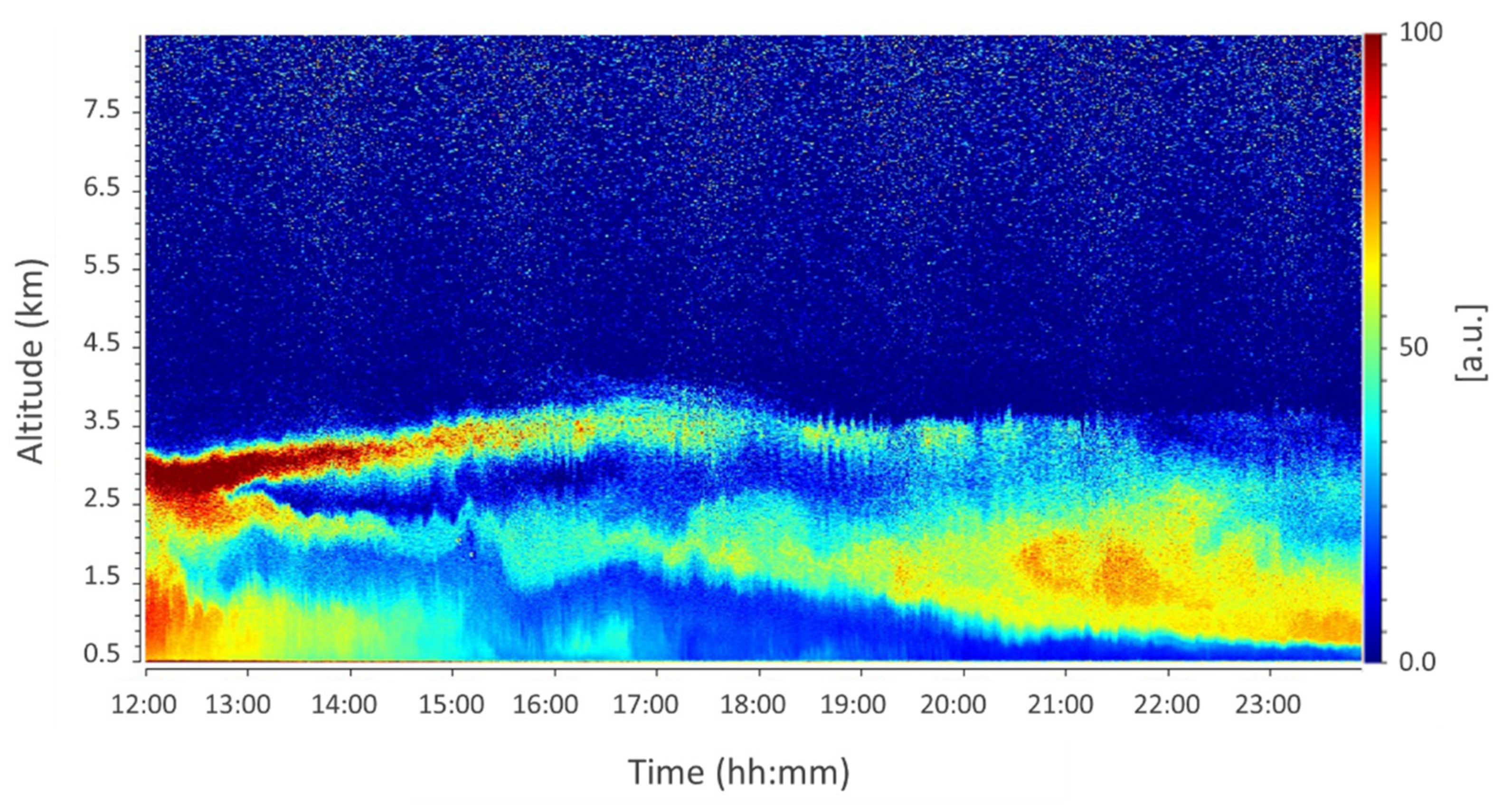

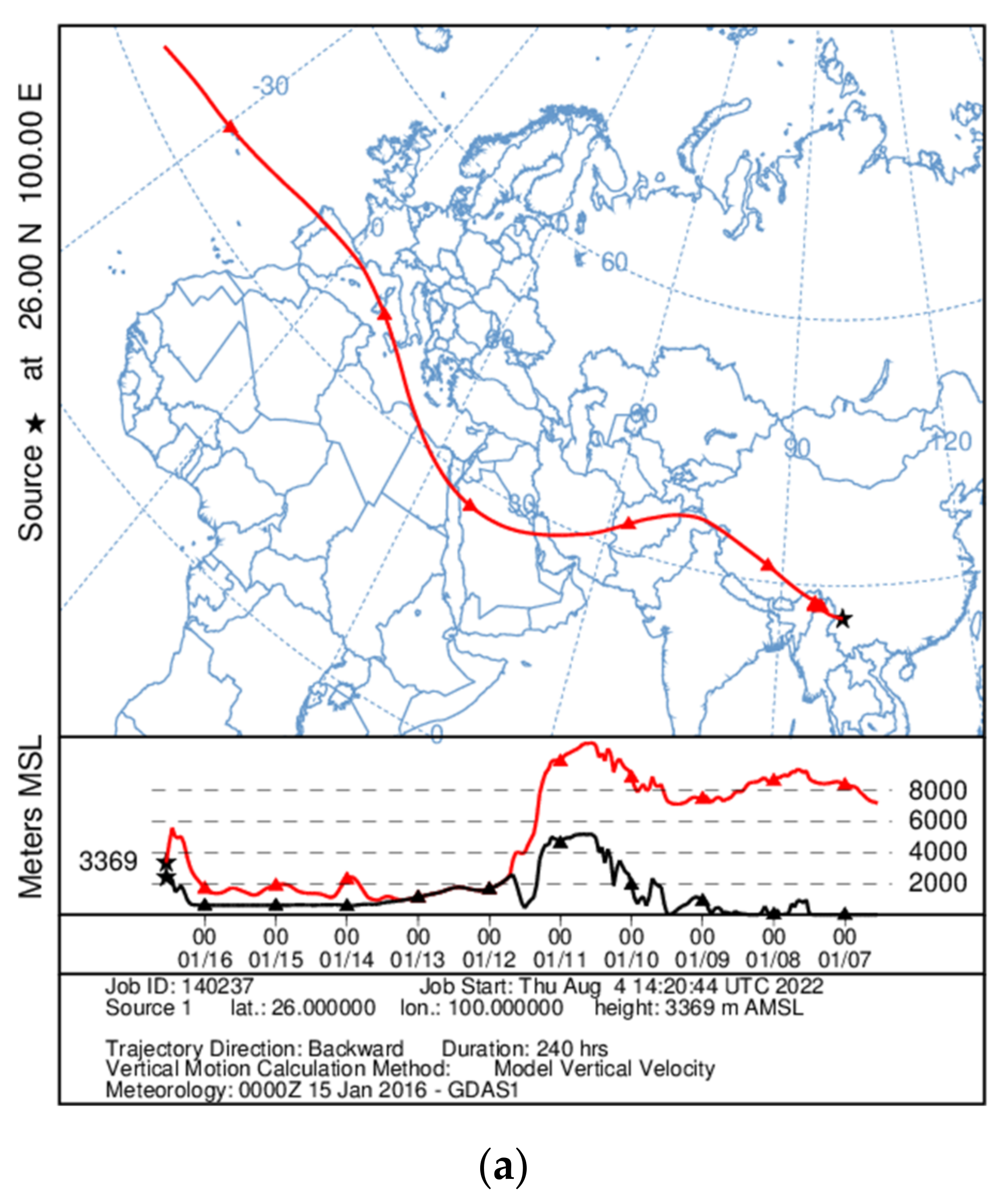
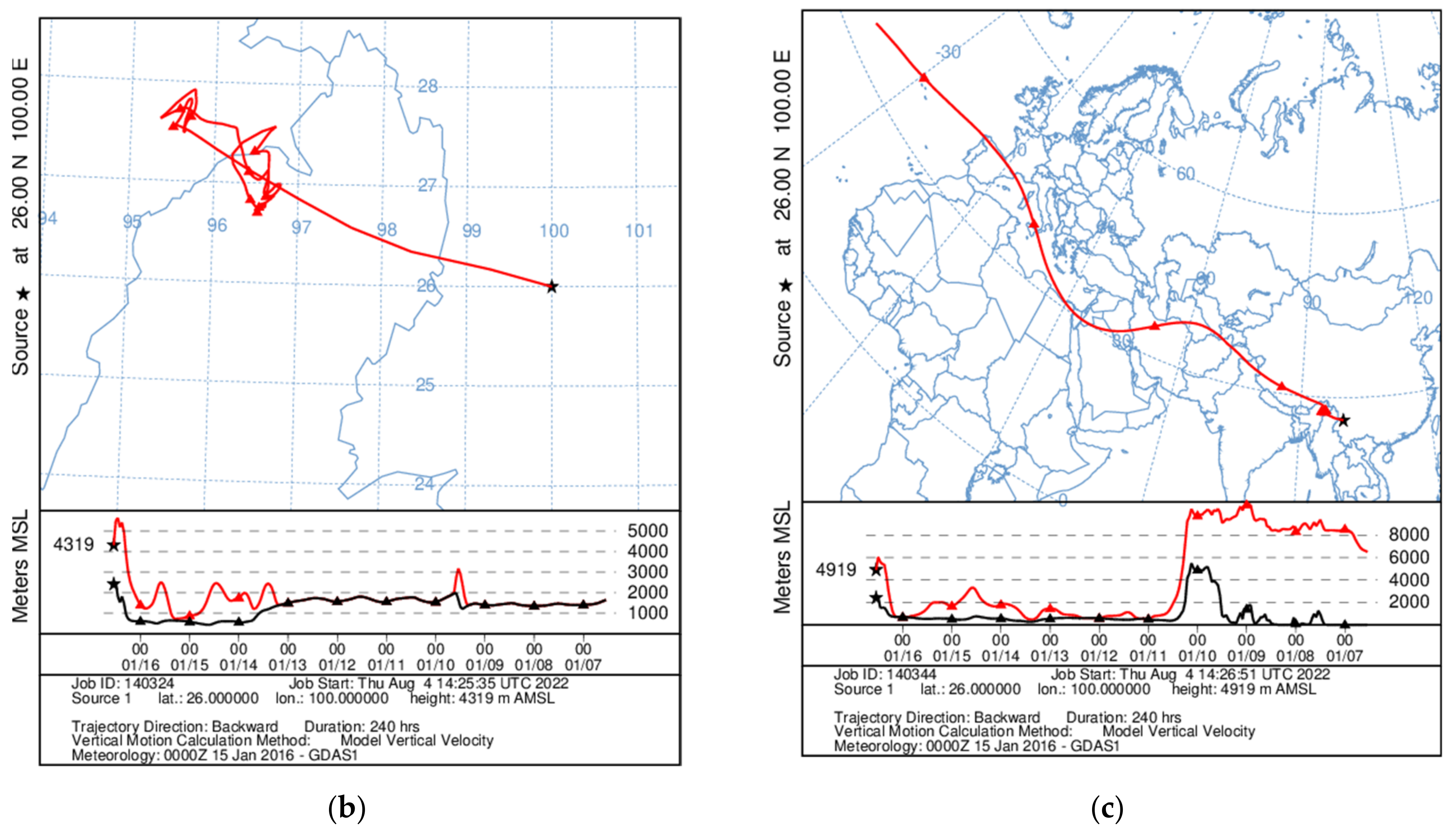
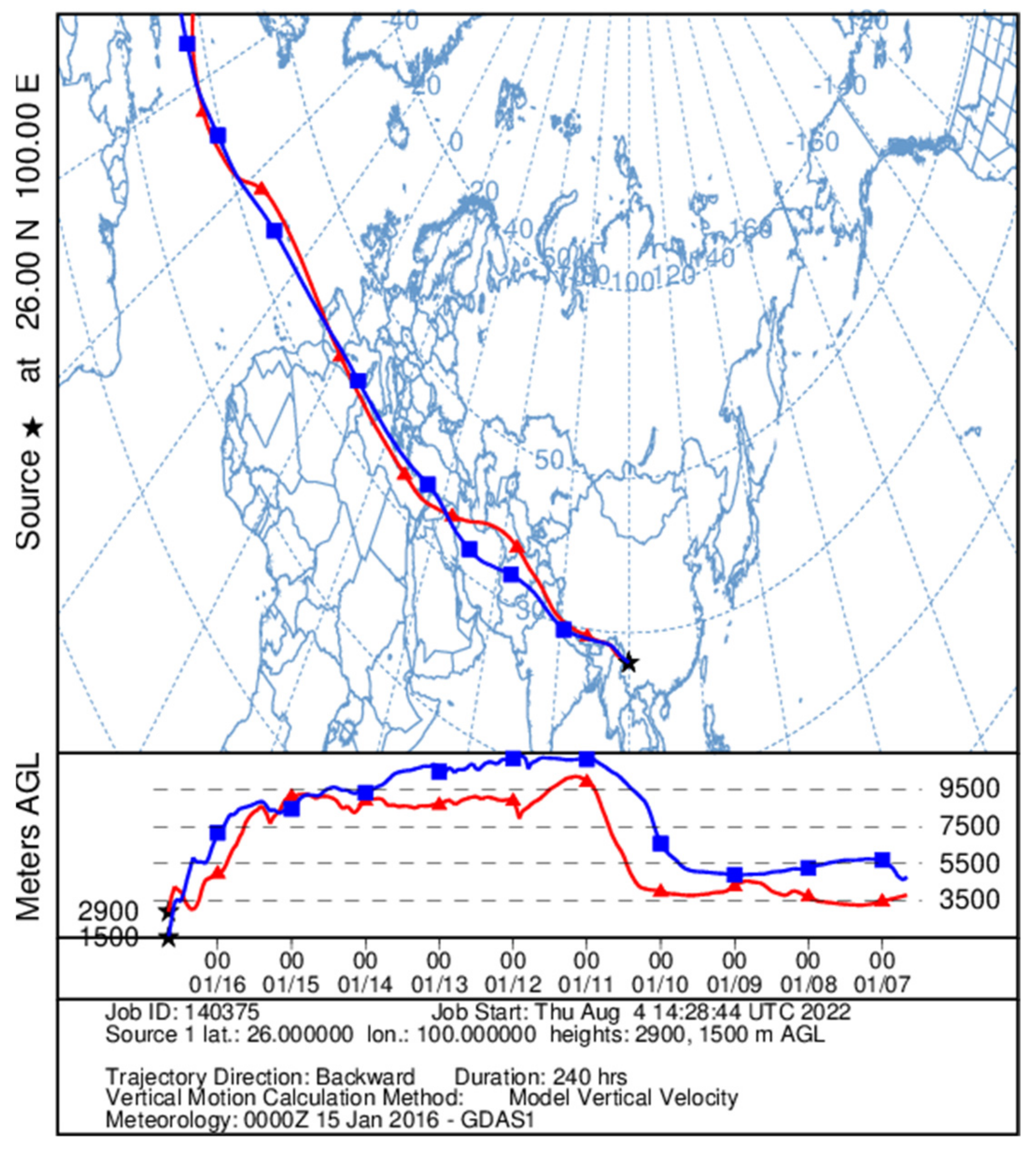
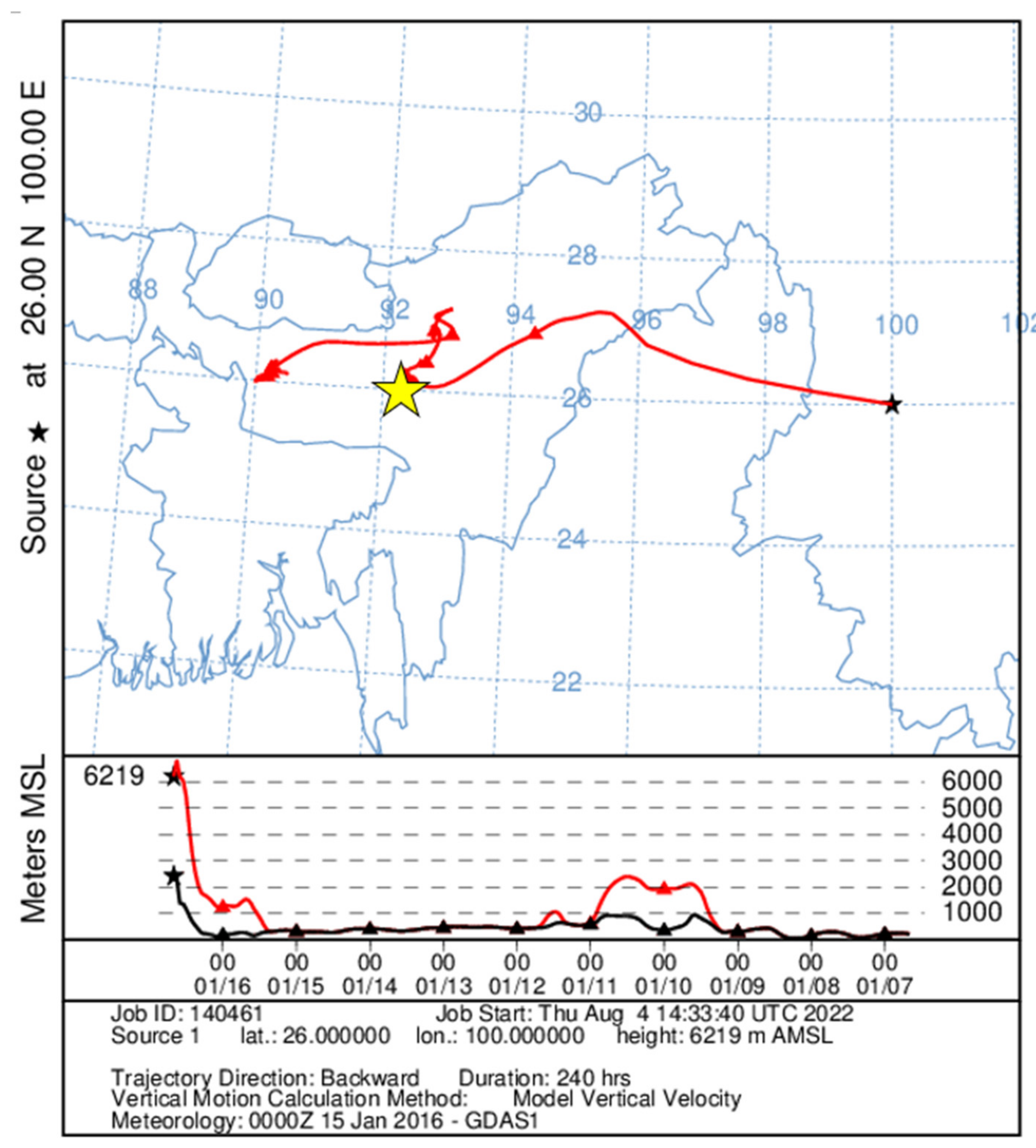
| Layer (m) @13.00 UTC | CR | δa (%) | Layer (m) @16.00 UTC | CR | δa (%) |
|---|---|---|---|---|---|
| 1000–1400 | 0.6 ± 0.1 | 8 ± 5 | 1000–2340 | 0.9 ± 0.1 | 12 ± 2 |
| 1400–2190 | 0.8 ± 0.1 | 14 ± 2 | 2340–3390 | 1.6 ± 0.2 | 19 ± 3 |
| 2190–3030 | 0.9 ± 0.2 | 30 ± 2 | – | – | – |
Publisher’s Note: MDPI stays neutral with regard to jurisdictional claims in published maps and institutional affiliations. |
© 2022 by the authors. Licensee MDPI, Basel, Switzerland. This article is an open access article distributed under the terms and conditions of the Creative Commons Attribution (CC BY) license (https://creativecommons.org/licenses/by/4.0/).
Share and Cite
Sannino, A.; Amoruso, S.; Boselli, A.; Wang, X.; Zhao, Y. Aerosol Monitoring at High Mountains Remote Station: A Case Study on the Yunnan Plateau (China). Remote Sens. 2022, 14, 3773. https://doi.org/10.3390/rs14153773
Sannino A, Amoruso S, Boselli A, Wang X, Zhao Y. Aerosol Monitoring at High Mountains Remote Station: A Case Study on the Yunnan Plateau (China). Remote Sensing. 2022; 14(15):3773. https://doi.org/10.3390/rs14153773
Chicago/Turabian StyleSannino, Alessia, Salvatore Amoruso, Antonella Boselli, Xuan Wang, and Yiming Zhao. 2022. "Aerosol Monitoring at High Mountains Remote Station: A Case Study on the Yunnan Plateau (China)" Remote Sensing 14, no. 15: 3773. https://doi.org/10.3390/rs14153773
APA StyleSannino, A., Amoruso, S., Boselli, A., Wang, X., & Zhao, Y. (2022). Aerosol Monitoring at High Mountains Remote Station: A Case Study on the Yunnan Plateau (China). Remote Sensing, 14(15), 3773. https://doi.org/10.3390/rs14153773









